|
1.
CENTRAL AND WEST AFRICA
Overall impression of weakening demand
Producers in the region have reported that demand in
Belgium is currently experiencing a period of
sluggishness, adding that stocks padouk and doussie are
slow to move as buyers appear hesitant to make significant
purchases. There has been a weakening of FOB prices
particularly in Belgium and the Gulf States, say exporters.
Equatorial Guinea's Okoume sawn timber has entered the
market at a significantly lower price point than Gabon and
Congo, albeit with varying quality. This move has caused
concerns, especially among Chinese buyers.
Companies marketing in the Gulf State, such as Iraq and
Iran say market conditions are challenging due to high
stock levels and weak demand.
Mills in Gabon facing many challenges
Heavy rain continues to impact harvesting and production
in Cameroon and the Central African Republic. In Gabon
mill output has fallen as the government enforces
regulations, particularly labour laws.
The government in Gabon is taking a tough stance on
labour issues given the recent industrial action by workers
in the in special zones. There is an increased emphasis on
hiring Gabonese workers but there is a shortage of skilled
mechanics, drivers, sawmill operators and heavy
equipment drivers.
The government has responded by relaxing the transition
period of 2-4 months during which time companies are
required to reduce their expatriate workforce in favour of
hiring Gabonese nationals.
There are reports of unresolved worker overtime payment
discrepancies as some companies in the special economic
zones are yet to adhere to the government regulations.
Labour unrest has reportedly led several Indian and
Chinese peeler mills to reduce their workforce sparking
concerns about unemployment and potential production
cuts.
Some Indian factories have already announced their
intentions to close due to the current uncertainties and
difficult operating conditions in the special economic
zones where fees to zone management have been rising.
The forestry sector in Gabon appears to be undergoing a
significant transformation toward legal compliance with
enforcement of anti-corruption measures.
The new Minister of Forestry in Gabon is actively
enforcing forestry laws, ensuring proper documentation
and seizing abandoned logs over six months old.
Mills in Gabon Special Economic Zone account for
60% of exports
The domestic press in Gabon has reported that in 2022
operators in the Special Economic Zone (GSEZ) processed
1,153,599 cu.m of logs and exported 622,026 cu.m of
wood products, mainly veneer and sawnwood which
represented around 60% of Gabon's timber exports in
2022.
In recent years wood product exports have become the
second largest Gabonese export product behind oil and
ahead of manganese.
In related news, according to data from the latest Ministry
of the Economy Economic Report at the end of the second
quarter of 2023 timber production dropped by 29%
compared to the same period in 2022, from 1.3 million
cu.m the end of June 2022 to 982,006 cu.m at the end of
June 2023.
This fall, says the report, was the result of logistical
problems in the sector, particularly linked to recurring
incidents on the railway and the poor state of the road
network during the rain season, difficulties which have
negatively affected the supply to mills, particularly those
in the Nkok special investment zone.
See:https://www.lenouveaugabon.com/fr/agro-bois/1110-20179-en-2022-la-vente-du-bois-transforme-par-la-gsez-a-represente-60-des-exportations-du-gabon
and
https://www.lenouveaugabon.com/fr/agro-bois/0410-20172-industrie-du-bois-la-production-chute-de-30-au-2e-trimestre-en-raison-des-difficultes-d-approvisionnement-des-usines
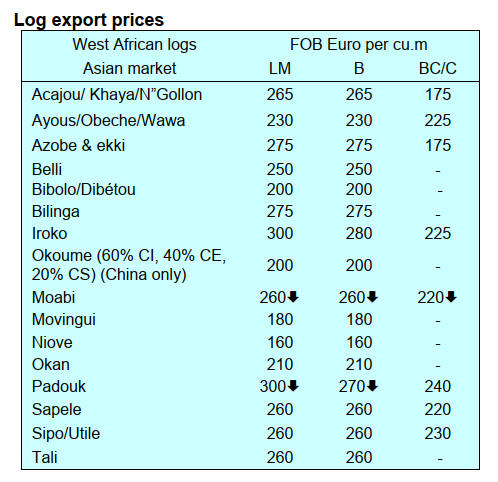
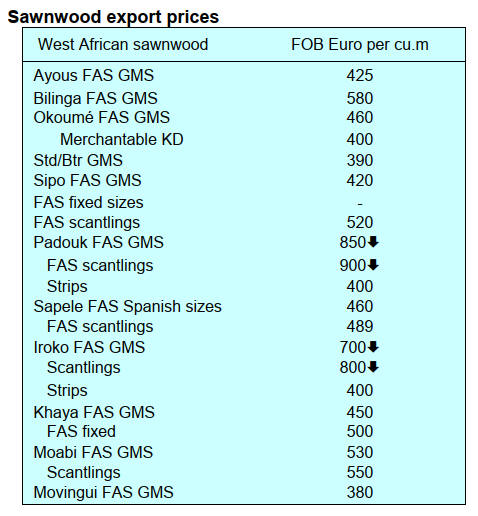
2.
GHANA
Second quarter export permits declined
The report from the Contract and Permit Unit of the
Timber Industry Development Division (TIDD) of the
Forestry Commission (FC) showed that the Unit received
a total of 1,023 applications for wood products export
permits in the second quarter of 2023.
The 1,023 applications covered a total volume of 79,860
cu.m of various timber and wood products valued at
Eur37.55million. These applications represented drop of
4% in permits, 10% in volume (cu.m) and 8% in value
when compared to the 1,069 applications recorded in
second quarter of 2022 which translated to 88,360cu.m
and Eur40.97million.

When compared to activities for the first quarter 2023 the
second quarter figures showed appreciable increases in all
the related areas as shown in table 2 below;
The data showed also that of the total 1,023 application
permits for the second quarter 2023 covered 11 different
wood products listed.
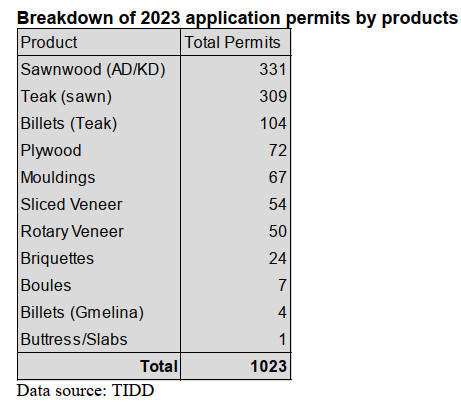
Air and kiln dried sawnwood, teak sawnwood and billets
accounted for 32%, 30% and 10% respectively of the total
permits applied for during the second quarter of 2023.
These altogether accounted for close to 73% of the total
permits for the period.
Some products that recorded increases in their number of
permits in Q2 over Q1 and these included air and kiln dry
sawnwood (640 permits) billets (gmelina 3 permits),
mouldings (7 permits) while applications for permits for
export of plywood, briquettes and boules dropped.
Half-year wood product exports drop marginally
According to a report from the Timber Inspection
Development Division (TIDD) exports of air-dried and
kiln-dried sawnwood topped Ghana’s first half-year timber
exports trade in 2023, accounting for 68% of the total
export volume for the period.
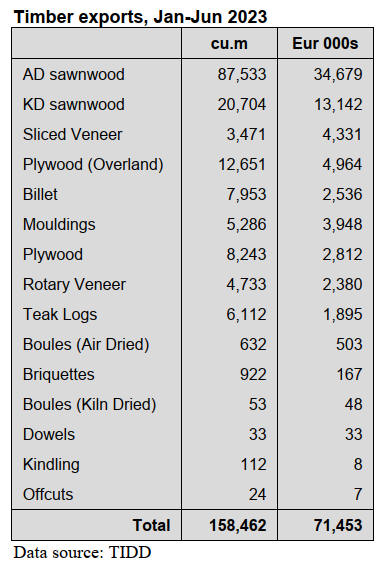
The total export volume for the period ending June 2023
was 158,462 cu.m compared to 165,630 cu.m in the same
period in 2022. The value of exports for the period was
Eur71.45 million in 2023 compared to Eur71.61 million in
2022.
The top species exported in the first half-year were
plantation teak, papao/apa, denya, dahoma, wawa,
mahogany and cedrella.
Plywood sold to regional West African markets and
transported by road was 12,651 cu.m which accounted for
8% of the total export volume and fetched the country
Eur4.96 million representing 7% of total receipts.
Sliced veneer topped the list of products with an average
unit price of Eur1,248/cu.m, followed by dowels at
Eur1,000/cu.m, while all other products were in the range
of Eur71/cu.m (kindling) to Eur906/cu.m (KD boules).
The overall average unit price for all export products for
the period in 2023 was Eur451/cu.m, higher than the
Eur432/cu.m recorded for the period in 2022.
The main markets in the first half of the year were India,
Saudi Arabia, Burkina Faso, Germany and United
Kingdom.
Ghana’s economy and non-performing loans
The Bank of Ghana’s Economic and Financial Data
released in September 2023 showed that Non- Performing
Loans hit a record high over the past five years.
Some commercial banks have linked this to the current
economic challenges facing the country which has made it
difficult for firms, including wood manufacturing
industries, to honour their debt obligations to banks.
But some industry experts have argued that the majority of
the bad loans can be linked to government’s debt due to
delayed payments to contractors on government projects.
Speaking on the topic, Dr. Alhassan Andani, a former
CEO of Stanbic Bank Ghana, noted that some of the
country’s current loan proposals must be scrutinised which
he believes could also help to reduce the Non-Performing
Loans owed to banks.
See:
https://www.myjoyonline.com/viable-projects-will-not-suffer-despite-banks-scaling-back-on-credit-dr-andani/
IMF cuts growth forecast
The World Bank recently lowered the country’s growth
rate forecast for this year to 1.5% according to its October
2023 Africa Pulse Report. The Fund cited fiscal slippages
as a result of high debt and budget deficits and reduced
government spending on infrastructure as major reasons.
Meanwhile, the Government has placed new restrictions
on borrowings by State Owned Enterprises (SOEs) and
other entities to check the country’s rising debts.
These restrictions are captured in Ghana’s new Debt
Management Strategy document.
See:
https://www.myjoyonline.com/world-bank-revises-ghanas-gdp-growth-marginally-to-1-5-for-2023/
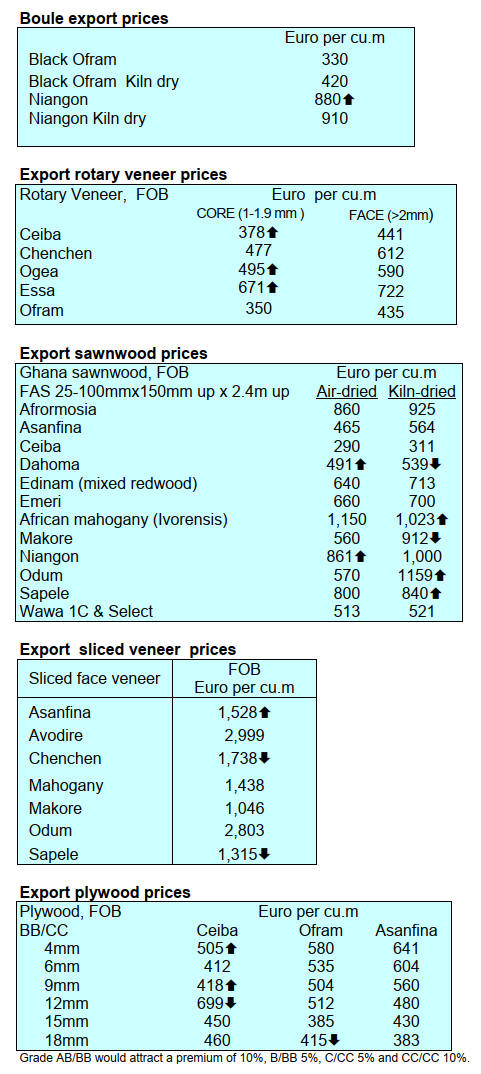
3. MALAYSIA
Malaysia launches carbon
exchange
Malaysia’s Bursa Carbon Exchange (BCX) has launched
continuous trading and facilitation of off-market
transactions for carbon credits. The exchange provides a
platform for companies to trade carbon credits,
encouraging carbon reduction initiatives and promoting
sustainability.
Continuous trading entails participating in the immediate
trading of regular contracts on the market. On the other
hand, off-market transactions are those that are negotiated
bilaterally between the buyer and seller. These
transactions occur outside of the exchange platform and
are usually facilitated after both parties have undergone a
clearance process with Bursa Malaysia.
Within the first two days of trading 10 companies
successfully transacted 16,500 Verra-registered carbon
credits on the exchange.
See:
https://www.nst.com.my/business/corporate/2023/09/959997/bursa-malaysia-kicks-carbon-credits-market-deals
and
https://carbonherald.com/malaysia-officially-launches-carbon-exchange/
C&I for non timber forest products
The Malaysian Timber Certification Council (MTCC) has
published ‘Guidelines on the Application of Requirements
for the Certification of Non-Timber Forest Products in
MTCS ST 1002:2021 Malaysian Criteria and Indicators
for Sustainable Forest Management’.
These guidelines, approved by the MTCC Board of
Trustees in September, form one item in the MTCC
Strategy 2020-2025 to include non-timber forest products
(NTFP) in the scope of certification.
These Guidelines are to be included within the scope of
certification under MTCS and will be useful to assist
users, particularly forest managers, in expanding the scope
of products covered under certification and allowing
relevant forest-related stakeholders along the supply chain
to benefit from the certification of all forest products,
including NTFP originating from certified FMUs.
The Guidelines can be downloaded at:
https://mtcc.com.my/wp-content/uploads/2023/09/Guidelines-Application-Req-Certification-of-NTFP-4-Sep-2023.pdf
Training on High Conservation Value and High Carbon
Stock Approach
WWF-Malaysia (Sarawak), the Sarawak Forest
Department and the Sarawak Timber Association jointly
organised two recent events, the High Conservation Value
- High Carbon Stock Approach (HCV-HCSA) Assessor
Training Course and a HCV Screening Workshop for
managers of the Permanent Forest Estate (PFE) in
Sarawak.
These events aimed to support continuous growth of
expertise among HCV practitioners in Sarawak thereby
enhancing their proficiency in conducting HCV
assessments within the context of forest management
certification schemes.
Participants were introduced to HCV and HCSA, HCV
screening and HCV-HCSA assessments and also key
concepts of assessments.
The training also touched on social prerequisites and
introduced participants to the concept of Free, Prior, and
Informed Consent (FPIC) in the context of HCV-HCSA
assessments.
See:
https://www.sta.org.my/images/STAReviewAug23.pdf
Engineered wood product development in Sarawak
Sarawak Timber Industry Development Corporation
(STIDC) has embarked on a collaborative effort with
experts from Universiti Teknologi Mara (UiTM) to shape
the path of engineered wood product development in
Sarawak. In the Post Covid-19 Development Strategy
(PCDS) 2030 Sarawak is pursuing the development of
high value added industries with a special focus on
engineered wood, furniture and bamboo-based products.
The General Manager of STIDC said it is imperative for
Sarawak to establish a first-class centre for research and
development, particularly concerning product performance
in the engineered wood sector.
See:
https://www.pressreader.com/malaysia/the-borneo-post/20231005/281827173406316
Production of high value-added wood products and
wooden furniture
A programme, TIMB3R DIP 3.0, to encourage production
of high value-added timber and furniture products with
creative and unique designs has been arranged by the
Malaysian Timber Council, the Malaysian Wood
Moulding and Joinery Council, the Malaysian Furniture
Council and the Malaysian Institute of Interior Designers.
The joint organisers are preparing for the upcoming
exhibitions REKA Interiors Exhibition 2023 in October
and the Export Furniture Exhibition in March 2024.
See:
https://mtc.com.my/images/cms/TIMB3R_DIP_2.0_-_Manufacturer_T-C_-_Self-Declaraton_Form.pdf
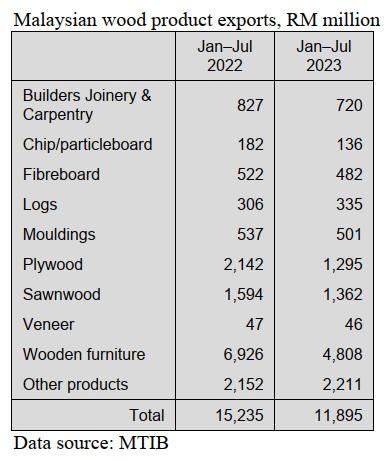
4.
INDONESIA
Benchmark export prices
for October 2023
The Ministry of Trade released the Export Benchmark
Prices (HPE) for wood products which took effect 1
October. The HPE was raised for several wood products
such sawnwood with a cross-sectional area of 1,000
sq.mm to 4,000 sq,mm from mixed tropical wood, teak
and sengon.
The HPE was lowered for veneer from plantation forests,
wood chips/particles, chipwood and sawnwood with a
cross-sectional area of 1,000 sq.mm to 4,000 sq.mm from
plantation forests e.g. balsa and eucalyptus.
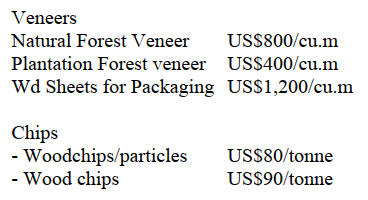
Processed Wood
Processed wood products which are leveled on all four
sides so that the surface becomes even and smooth with
the provisions of a cross-sectional area of 1000 sq.mm to
4000 sq.mm (ex 4407.11.00 to ex 4407.99.90)
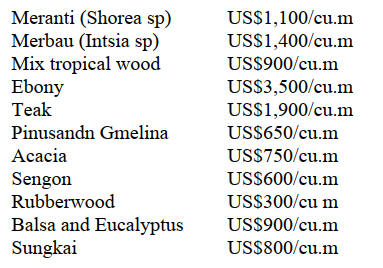
Processed wood products which are leveled on all four
sides so that the surface becomes even and smooth with
the provisions of a cross-sectional area of 4000 mm2 to
10000 mm2 (ex 4407.11.00 to ex
4407.99.90)

See:
https://forestinsights.id/harga-patokan-ekspor-hpe-kayu-oktober-2023-wood-chips-hutan-tanaman-turun/
Carbon exchange encourages green funding
Indonesia has prepared a funding strategy for reducing
carbon emissions from the forestry sector and land use in
general through a carbon exchanges. The chairperson of
the Board of Commissioners, Financial Services Authority
(OJK), Mahendra Siregar, said that President Joko Widodo
has launched the Indonesian Carbon Exchange.
He added "this (exchange) aims to provide a market
mechanism that will support the government's NDC
targets while balancing the transition to a sustainable
economy."
See:
https://www.kompas.id/baca/english/2023/09/25/en-pendanaan-hijau-di-sektor-kehutanan-dan-penggunaan-lahan-menjanjikan?loc=metered_register_wall-mrw-1
Strategy to balance industrial wood production and
ecosystem restoration
The Director General of Sustainable Forest Management,
Ministry of Environment and Forestry, Agus Justianto,
presented a strategy for integrating sustainable wood
supply with forest restoration through ecosystem
restoration and a multi-businesses approach when he was a
panelist at Dialogue Day held during the 30th Asia Pacific
Forestry Commission in Australia. The event was
organised by FAO in collaboration with the Australian
National University.
Agus explained that Indonesia encourages the
implementation of sustainable production forest
management to meet industrial requirements as well as
efforts on land rehabilitation. Efforts are being made to
return forest landscapes to their original condition through
a business approach which incorporates ecosystem
restoration. Agus said that the wood processing industry in
Indonesia is currently improving efficiency in order to
survive amidst the limited availability of raw materials.
He added “a broader approach that integrates
environmental and social aspects is an alternative for
success in the forest product processing sector". The
government, together with the community, business actors
and other stakeholders are encouraged to implement a raw
material supply chain from the sustainably managed
forests.
See:
https://agroindonesia.co.id/indonesia-bagikan-strategi-capai-keselarasan-pemenuhan-kebutuhan-kayu-industri-dan-restorasi-ekosistem/
Energy forests developed for biomass supply
Energy forests are being developed to create a biomass
supply chain. The Indonesian Primary Energy Subholding
(PLN EPI) is planting of energy forests on barren land
owned by communities. PLN EPI President, Iwan Agung
Firstantara, explained that energy forest development is
one of the current focuses considering that co-firing
technology or coal substitution in Steam Power Plants
(PLTU) is one of the strategic steps to reduce carbon
emissions.
The Vice President for Biomass Procurement, Control and
Logistics at PLN Energi Primer Indonesia (EPI), Erfan
Julianto, explained that by 2025 the biomass requirement
for the PLN Group's 52 Steam Power Plants will reach
10.2 million tonnes. Biomass sources such as sawdust,
wood chips and reject wood will be the main raw material.
See:
https://wartaekonomi.co.id/read515747/jaga-rantai-pasok-biomassa-pln-epi-sulap-lahan-tandus-dan-rehabilitas-hutan-jadi-katalis-ekonomi-rakyat
The economic value of carbon
The National Research and Innovation Agency (BRIN) is
committed to contributing to the target of reducing Green
House Gas (GHG) emissions in the forestry sector. BRIN,
through the Ecology and Ethnobiology Research Center
(PREE) and the Biological and Environmental Research
Organisation, is currently focusing on determining the
appropriate instruments or methods for the measurement
and monitoring aspects of the implementation of the
Economic Value of Carbon.
The Head of PREE BRIN, Anang Setiawan Achmadi, said
one of the efforts to control GHG emission is through
Presidential Regulation Number 98 of 2021, an important
tool in supporting the implementation of climate change
policies, investment and sustainable business practices.
Anang said there was a need for a Measurement Reporting
Verification (MRV) system to ensure reliable
measurements or monitoring especially regarding changes
in carbon and carbon stocks so as to produce data and
information that are transparent, accurate, complete,
comparable and consistent.
See:
https://sawitindonesia.com/brin-berkomitmen-dalam-target-penurunan-emisi-grk-pada-sektor-kehutanan/
President orders immediate action against forest fires
President Joko Widodo today warned that smoke from
forest and land fires in the country has the potential to
spread widely. He also ordered that top military and police
officers as well as the regional governments take
immediate action to overcome the problem.
He was commenting on the increase in air pollution in
neighbouring countries following the smoke from fires in
Sumatra and Kalimantan.
See:
https://www.themalaysianinsight.com/s/465755
In related news, forest fires in Indonesia have declined and
no haze had been detected moving to Malaysia according
to the Ministry of Environment and Forestry a day after
Malaysia urged Jakarta to take action as air quality
worsened.
See:
https://www.thejakartapost.com/indonesia/2023/10/06/environment-minister-says-no-transboundary-haze-to-malaysia-fires-on-decline.html.

5.
MYANMAR
6.
INDIA
Growing demand for WPCs
Builders in India say that the cost of wood is now very
high and its use in the industry is time-consuming and that
is why Wood/Plastic Composites (WPC) are a suitable
alternative, particularly when ready-to-use products are
available. Builders point out that the supply of WPC
products has increased many fold which has helped drive
demand.
Besides the high price of timber, demand for WPC doors,
frames and windows have the advantage of meeting
environmental guidelines on fire rated doors in
government buildings and high-rise buildings. WPC
products are also promoted as waterproof, termite-proof
and eco-friendly which has given a boost to demand for
WPC doors and door frames. The India WPC market
could reach US$0.413 million by 2028.
See:
https://www.imarcgroup.com/india-wood-plastic-composites-market
Plywood imports from Nepal
Indian markets mainly in the north and north eastern areas
of India are, according to Plyreporter, seeing a rise in
plywood manufactured and shipped from Nepal.
Evidently the raw material for plywood manufacture is
readily available in Nepal unlike the situation in India
where plywood mills struggle to secure peelable logs. It
has been reported that domestic demand for plywood in
Nepal has declined recently as economic growth has
slowed.
Plyreporter says “Nepal makes plywood at nearly 20%
economical than in India made and is available in the
market at Rs 40 to 45 that is posing stiff competition to the
mid-segment plywood players in India. The Nepal made
plywood has been reaching in north India, Rajasthan,
central India markets and Maharashtra“.
See:
https://www.plyreporter.com/article/143755/indian-market-breeding-base-for-nepal-plywood-industry
Monsoon rains below normal – economy impacted
The southwest monsoon, vital for the agricultural sector in
India, ended with rains that were 'below normal', the first
in four years. India saw a rainfall deficit of 6% in the 2023
monsoon. While this may seem small does not capture the
very variable distribution of rainfall over India. Six states,
Assam, Manipur, Mizoram, Jharkhand, Bihar and Kerala
recorded major deficits according to the meteorological
authorities.
A normal and well-distributed monsoon is crucial for the
60% of Indian farmers who are dependent on rain. Around
50% India's planted farm land is rain-dependent and
produces 34 of the country's 40 plus major crops. The
monsoon has a direct impact on India's economy. A
successful monsoon season boosts farm production and
income of both farmers and labourers. This in turn has an
impact on rural household incomes which stimulates
demand for goods and services in rural areas.
Repeated crop losses due to erratic rain have led to
increases in prices of essential commodities and also some
trade restrictions. Farm incomes have fallen reducing rural
consumption which has a direct impact on various sectors
of the economy. Companies have been reporting a dip in
sales of consumer goods. There has been a rise in
unemployment and the national unemployment rate rose to
8.1% in August 2023 from around seven per cent in June.
Fewer job opportunities has forced many to seek work
under Mahatma Gandhi National Rural Employment
Guarantee Scheme (MGNREGS), India's rural
employment programme.
See:
https://www.downtoearth.org.in/news/agriculture/explained-how-is-below-normal-monsoon-2023-impacting-india-s-economy-92183
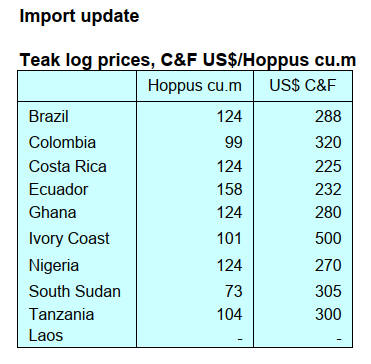  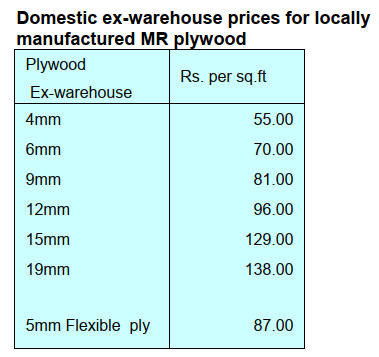
7.
VIETNAM
Wood and Wood Product (W&WP) trade highlights
W&WP exports to the US in September 2023 were
recorded at US$627 million, up 9.3% compared to
September 2022. Over the past few months W&WP
exports to the US have been improving. The rate of
decline in W&WP exports to the US in the first 9 months
of 2023 has slowed reaching US$5.2 billion, down 24%
over the same period in 2022.
In September 2023, Vietnam’s exports of kitchen furniture
amounted to US$102 million, up 15% compared to
September 2022. In the first 9 months of 2023 exports of
kitchen furniture were worth at US$812.5 million, down
21% over the same period in 2022.
Vietnam's pine imports in September 2023 were 92,400
cu.m, worth US$20.5 million, up 36% in volume and 35%
in value compared to August 2023. Compared to
September 2022 imports increased by 25% in volume and
12% in value. In the first 9 months of 2023 pine wood
imports reached 514,100 cu.m, worth US$113.2 million,
down 36 in volume and 49% in value over the same period
in 2022.
In September 2023 Vietnam’s exports of living and
dining-room furniture was valued at US$215 million, up
2% compared to September 2022. Exports of living and
dining room furniture begins to recover and September
2023 marked the 5th consecutive month in which exports
increased.
Over the first 9 months of 2023 Vietnam’s exports of
living and dining room furniture stood at US$1.5 billion,
down 35% over the same period in 2022.
Vietnam's ash imports in September 2023 were 80,400
cu.m, worth US$19.7 million, up 36% in volume and 35%
in value compared to August 2023. Compared to
September 2022 the imports were up 54% in volume and
32% in value.
Over the first 9 months of 2023 ash imports reached
429,000 cu.m, worth US$109.6 million, up 19% in volume
and 16% in value over the same period in 2022.
In August 2023 Vietnam’s imports of logs and sawnwood
from Africa dropped very sharply to just 34,440 cu.m,
worth US$12.95 million, down 38% in volume and 35% in
value compared to July 2023 and year-on-year imports
were down 78% in volume and 79% in value. In the first 8
months of 2023 imports of logs and sawnwood were
reported at 503,040 cu.m, worth US$197.42 million, down
39% in volume and 36% in value over the same period in
2022.
Tropical hardwoods imported into Vietnam from Africa
are targeted entirely at the domestic consumers. This year,
the freezing of the real estate market added with the
economic slowdown has been hampering the consumption
of African hardwood. The imports of log/sawnwoods from
Africa, therefore, have reduced substantially. This trend is
forecasted to prevail in the next coming quarters.
With the steady bilateral relations between Vietnam and
the US due to the Comprehensive Strategic Partnership for
Peace, Cooperation and Sustainable Development,
Vietnam’s exports to the US are expected to expand.
Vietnamese enterprises, including wood product
manufactureres are expected to benefit.
In recent years, Vietnam has emerged as the top W&WP
supplier for the US market and exports to the US often
contribute 50 - 55% of the total Vietnam’s W&WP export
earnings. In the first 8 months of this year, due to the
declining demand, Vietnam’s W&WP exports to the US
dropped significantly.
In particular, the value of wooden furniture destined for
the US stood at US$3.9 billion, year-on-year down by
29%; wood-based panels and flooring US$371.8 million,
down 36% and wooden doors US$16.8 million, down
32%.
Vietnamese enterprises have assessed that the challenges
they are facing in the US market are of a short-term
nature.
W&WP exports to Japan tending to recover
In September 2023 Vietnam’s W&WP exports to Japan
were valued at US$158 million, down 0.3% compared to
September 2022. Over the first 9 months of 2023 W&WP
exports to Japan amounted to US$1.3 billion, down 8%
year-on-year.
Of all W&WPs exported to Japan during the first 8 months
of 2023 woodchips, wood pellets and indoor furniture
topped the list contributing up to 86% of total earnings.
Wood chip exports to Japan earned US$421 million,
drown 8% over the same period in 2022 followed by wood
pellets (US$281 million), up by 21% and wooden furniture
(US$263.3 million), down by 29%.
From the beginning of this year, Japan's wood pellet
imports were increasing as many large biomass power
plants came on-line. According to statistics from Japan
Customs Agency HS code 4401 imports (woodchip and
wood pellet) in the first 8 months of 2023 topped 11.7
million tonnes, worth 335.3 billion yen (equivalent to
US$2.2 billion, up 13% in volume and 30% in value over
the same period in 2022.
Vietnam is the top supplier of pellets but the growth of
exports from Vietnam to Japan has slowed. In the first 8
months of 2023 Japan expanded wood pellet imports from
the US up to 1.6 million tonnes, a 106% increase over the
same period in 2022.
In the first 8 months of 2023 Vietnam remained the second
largest supplier of wooden furniture to Japan. In this
period, Vietnam shipped furniture worth 37.3 billion yen
(equivalent to US$250 million), down 27% in volume and
25% in value year-on-year.
Padauk and pachy/ doussie wood suppliers
Cameroon remains the top supplier of padauk and
pachy/Doussie for Vietnam. In August 2023 Cameroon
shipped to Vietnam 19,930 cu.m, with a value of US$8.63
million, down 23% in volume and 16% in value compared
to July 2023 and down 16% in volume and 69% in value
compared to August 2022.
Over the first 8 months of 2023 imports of logs and
sawnwood of all species from Cameroon to Vietnam
reached 291,440 cu.m with a value of US$127.67 million,
down 22% in volume and 20% in value over the same
period in 2022.
Imports of padauk and pachy/Doussie from Angola in
August 2023 amounted to 3,380 cu.m with a value of
US$939,000, down 55% in volume and 52% in value
compared to July 2023 but up 21% in volume and 11% in
value compared to August 2022.
Over the first 8 months of 2023 imports of raw padauk and
pachy/doussie wood from Angola amounted to 39,070
cu.m, witha value of US$10.36 million, down 1% in
volume but up 2.0% in value over the same period in
2022.
Ghana is one of the few suppliers that has
increasedshipments to Vietnam as in August 2023 imports
were 1,340 cu.m, worth US$413 thousand, up 44% in
volume and 53% in value compared to July 2023, yet
down 67% in volume and 70% in value compared to
August 2022. Over the first 8 months of 2023, imports of
raw wood from Ghana reached 10,290 cu.m, with a value
of US$2.80 million, down 56% in volume and 63% in
value over the same period in 2022.
Price fluctuations
Logs: The price of logs imported from Africa to Vietnam
in August 2023 averaged US$399 per cu.m, up 9%
compared to July 2023 and up 2.4% over the same period
in 2022.
Over the first 8 months of 2023 the average import price
of logs from Africa was US$393 per cu.m, up 7% over the
same period in 2022.
Tali has been dominating log imports from Africa to
Vietnam reaching 8,900 cu.m, with a value of US$3.15
million in August 2023, down 39% in volume and 36% in
value compared to July 2023 and down 76% in volume
and 78% in value compared to August 2022.
Over the first 8 months of 2023 imports of tali roundwood
from Africa reached 124,050 cu.m, with a value of
US$45.56 million, down 28% in volume and 29% in value
over the same period in 2022.
Sawnwood imports from Africa to Vietnam in August
2023 reached 16,600 cu.m, with a value of US$5.80
million, down 40% in volume and 40% in value compared
to July 2023 and down 63% in volume and 67% in value
compared to August 2022.
In the first 8 months of 2023 sawnwood imports from
Africa to Vietnam reached 238,400 cu.m, with a value of
US$93.34 million, down 24% in volume and 23% in value
over the same period in 2022.
In August 2023 imports of sawnwood of the 3 top species
including tali, padauk and pachy/doussie from Africa to
Vietnam dropped sharply against July 2023 and year-on-
year.
Over the first 8 months of 2023 imports of tali sawnwood
increased slightly by 3% in volume and 7% in value over
the same period in 2022. At the same time imports of sawn
padauk decreased by 3% in volume and 7% in value.
Imports of sawn pachy/doussie plummeted by 55% in
volume and 55% in value.
In the first 8 months of 2023 the average import price of
sawn tali was US$452 per cu.m, up 4% over the same
period in 2022. The sawn padauk price was US$292/cu.m,
down 4% and the average price of pachy/dousie was
US$414/cu.m, down 1%.
Outlook for wood products exports to UK
W&WP exports to the UK as well as some other EU
markets are expected to recover from the end of this year
after a significant drop. Ngô Sỹ Hoài, Vice President and
Secretary General of the Vietnam Timber and Forest
Products Association (VIFOREST) said exports to the UK
were worth US$124 million in the first eight months, a
year-on-year decrease of 27%.
Vietnam also earned US$28 million from the export of
non-timber forest products (rattan, bamboo, rush, carpet,
etc.) to the UK in the first eight months, a 4% year-on-year
decrease. The UK is among the crucial export markets for
Vietnamese wood products and serves as a gateway to
Europe. Vietnamese woodworking firms have shown great
interest in this market.
The export of wood and wood products to the UK is
relatively stable and substantial, usually accounting for a
third of the total exports to Europe, Hoài said.
“Currently, there are challenges in the global market with
exports to many markets decreasing. However, firms
should steadfastly continue promoting exports to the UK.
Hopefully, these challenges are temporary.
In the long run, said Hoai “the UK remains a key market
for indoor and outdoor furniture, especially those with
high added value.”
The UK-Vietnam Free Trade Agreement (UVNAFTA)
signed in May 2021 is an important continuation of trade
facilitation between the two countries after the UK exited
the EU. The agreement has enhanced opportunities to
export Vietnamese products through the increased access
to the UK market. Therefore, there are no policy
difficulties when exporting to the UK.
Currently, Vietnamese firms export only outdoor furniture
and handicrafts to the EU, mainly Germany, the
Netherlands and Belgium but can sell a lot of indoor
furniture to the UK, said Nguyễn Chánh Phương, deputy
chairman of the Handicrafts and Wood Industry
Association of HCM City (HAWA). “British and
American tastes are similar” he added.
But Hoài and Phương shared the opinion that the UK has
introduced new initiatives and regulations related to green
production and sustainable development to minimise the
impacts of climate change, reduce greenhouse gas
emissions, curb deforestation and preserve biodiversity.
These present challenges for Vietnamese exporters but
businesses must strive to comply with its regulations, they
said.
Hoài said: “This is a market with quite strict regulations.
However, firms that successfully enter the market can
demonstrate their ability to expand their products to other
demanding markets since they satisfy strict requirements
in terms of the environment, ensuring a legal timber
source and sustainable forest management.
“Despite current difficulties, firms should strive
to
maintain trade ties in the wood sector with the UK market;
exports to this market will definitely grow again,” he
added.
Eight-months’ exports
HAWA Deputy Chairman, Phương, said total W&WP
exports declined by nearly 26% in the first eight months of
the year to US$8.3 billion with exports to key markets
such as the US, EU and the UK experiencing significant
drops.
The decrease was primarily driven by high inventories and
weak demand due to high inflation prompting consumers
to reduce consumption of non-essential goods, including
wood and wood products. However, since May there have
been signs of recovery with exports averaging over
US$1.2 billion per month, he said.
Huỳnh Quang Thanh, CEO of Hiệp Long Fine Furniture
Company, said buyers in many markets had "over-
ordered" products last year in response to supply-chain
issues and shortages leading to the high inventories.
Statistics from international organisations show global
inventories have significantly reduced and buyers in many
markets have resumed ordering since July, he said. He
added “the number of orders is expected to surge from
October to pre-pandemic levels.”
His company has secured enough orders to retain all of its
workers until the end of the year he said. He added that his
company’s key markets include the US, EU, northern
Europe and the Middle East.
Lê Xuân Tân, managing director of Happy Furniture,
which exports indoor and outdoor furniture to major
markets such as the US, EU and Australia (with exports to
the UK accounting for 15% of its exports) said demand for
furniture typically picks up in the fourth quarter every year
as people prepare for the year-end holiday season.
Buyers now tend to order smaller volumes than before and
delivery times are shorter and so firms need to prepare raw
materials, personnel and production facilities well in
advance to meet buyers’ demands, he said.
See:
https://vietnamnews.vn/economy/1594666/outlook-for-wood-products-exports-to-uk-remains-optimistic.html
8. BRAZIL
New regulation for logging
in the Amazon
The Mato Grosso State Secretariat for the Environment
(SEMA-MT) has announced new regulation (Normative
Instruction nº 6/2023) for logging, aimed at improving
administrative procedures and preventing the possibility of
fraud.
The main changes brought about by the regulation are
procedures for the effective control of logged trees and
their location in the forest after sawing, using tracking and
environmental monitoring in approved management
projects.
These measures are considered essential by SEMA-MT to
strengthen inspection throughout the chain of custody
following the implementation of effective traceability of
timber in Mato Grosso state with the new System for
Commercialization and Transportation of Forest Products
(SISFLORA 2.0), implemented since April this year.
In addition, the regulation introduces a requirement for a
cargo waybill (romaneio), a document that contain a list of
information about the goods to be transported, such as the
tree number, the section number of the tree with the
diameter and length measurements and the actual volume
that is entered into SISFLORA 2.0 system.
From this system a QR Code tracking code is generated
which details information about each tree and its harvest
location. The state of Mato Grosso became the first state to
achieve 100% traceability of forest products which is
essential to ensure that timber is harvested legally opening
up opportunities in the strictest markets, including for
export.
See:
https://forestnews.com.br/mato-grosso-novas-regras-extracao-da-madeira/
Mato Grosso state - second largest timber
producer in
Brazil
The value of timber production from natural forests in the
state of Mato Grosso reached R$940.5 million in 2022
corresponding to 15% of the national total making it the
second largest timber producer from natural forests in the
country behind only Pará State in the Amazon Region
according to the State Secretariat for Economic
Development (SEDEC).
The states of Mato Grosso and Pará account for 71% of
the total roundwood harvested which represents 83% of
the total value of production. But, in terms of production
of charcoal, firewood and timber from plantations
production expanded but the State of Mato Grosso ranks
10th, accounting for just 2% of the national total.
Planted forest to secure resources
The release of financial resources for sustainable forest
management, investments in planted forests, recovery of
degraded areas and riparian forests, technical assistance
and forestry extension is being discussed by the
“Desenvolve Floresta” Management Board.
With resources from the “Develop Forest Fund” (Fundo
Desenvolve Floresta), it is possible to ensure that the State
of Mato Grosso has a supply of raw materials for the wood
products sector .
See:
https://cipem.org.br/noticias/mato-grosso-e-o-2o-do-pais-com-maior-valor-de-producao-extrativista-do-pais
Furniture exports improve
Brazilian furniture exports showed a positive performance
in July 2023 with international sales totalling US$62.0
million. This represents an increase of 5% over the
previous month (US$59.0 million). However, the sector
faces significant challenges as exports up to July dropped
16% compared to the same period in 2022 according to
IEMI (Institute for Industrial Studies and Marketing).
The United States, with market share of 33% leads the
way as the main export destination followed by Uruguay
(10%) and Chile (7%) as the furniture industry seeks to
overcome obstacles through innovation, quality control
and sustainability .
ABIMÓVEL has highlighted the challenges including
global inflation, geopolitical uncertainties and changing
consumer demands especially in relation to economic and
environmental sustainability.
The Brazilian furniture industry is seeking to overcome
these obstacles by looking for new market opportunities
through commercial partnerships, investment in
innovation and design, as well as a strong commitment to
quality and sustainability management in the
standardisation. IEMI's projections point to an additional
growth potential of more than 18% in exports to the USA
over the next few years.
See:
https://forestnews.com.br/exportacoes-moveis-colchoes-crescem-segundo-semestre/
Brazilian Forest Service discusses forest carbon
resources
The Brazilian Forest Service (SFB) took part in the
Carbon Project Benefit Sharing Seminar held in
Molloolaba, Queensland, Australia. The event discussed
benefit sharing in forest restoration projects that generate
carbon credits. Benefit sharing is the transfer of monetary
and non-monetary incentives, such as goods, services and
infrastructure, to participants in a forest restoration project.
The seminar was attended by researchers, representatives
of the third sector and the private sector and government
officials from Brazil and Australia.
For SFB defining how the benefits, costs and risks are
shared among landowners, local communities, project
developers and investors is fundamental to the interests of
all participants and social justice. Payment for forest
carbon has the potential to leverage forest restoration.
SEE:
https://www.gov.br/florestal/pt-br/assuntos/noticias/servico-florestal-participa-de-discussoes-sobre-recursos-do-carbono-florestal

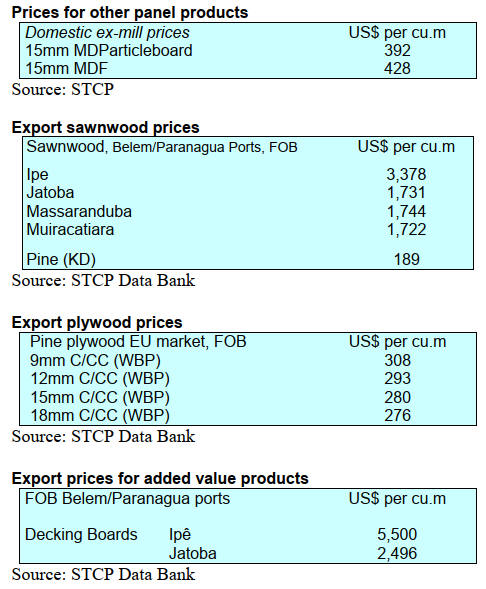
9. PERU
New financial
instruments for Amazon forests
Amazon Forests S.A. (BAM) plans to issue sustainable
commercial papers through the Lima Stock Exchange
(BVL) with a view to scaling-up its conservation and
reforestation projects in the Peruvian Amazon, mainly in
Ucayali and Madre de Dios.
To date BAM has placed more than US$30 million worth
of instruments on to the market. BAM is now preparing
the first issuance of its third programme of sustainable
short-term instruments certified by Pacific Corporate
Sustainability (PCS).
The funds from the programme and from the next BAM
issuance will be used to expand projects with social and/or
environmental impact.
This will contribute to promoting the goals set in the
United Nations Sustainable Development Goals (SDGs),
specifically those related to the end of poverty; clean water
and sanitation, decent work and economic growth,
industry innovation and infrastructure and action for the
climate and terrestrial ecosystems.
See:
https://euro.eseuro.com/local/1179110.html
Trial of new system to manage forestry
information
The National Forestry and Wildlife Service (Serfor)
recently led trials of the “Forest Management” computer
system for the Control Module of the National Forestry
and Wildlife Information System (MC-SNIFFS) in
Ucayali.
This system will improve the management and handling of
forestry information benefiting State institutions and
companies in the country's forestry sector that work under
the standards established in forestry and wildlife
regulations in the country.
The trials were carried out in mid-September to confirm
the suitability of “Gestiona Forestal del MC-SNIFFS”, a
system that covers the functionalities in formulation,
evaluation and approval of forest management plans and
operational plans for timber forestry concessions.
The results of the tests showed a high degree of
acceptance of this management tool by specialists and
regents. In the coming months, SERFOR will begin the
deployment of the tool in its final phase, in order to
contribute to the sustainable management of the forest's
timber resources.
See:
https://www.gob.pe/institucion/serfor/noticias/840861-ucayali-serfor-realizo-con-exito-pruebas-del-sistema-informatico-gestiona-forestal-que-contribuira-a-mejorar-la-gestion-forestal
Lost opportunities
Erik Fischer, president of the ADEX Timber and Wood
Industries Committee, has questioned the low volume of
wood product exports from Peru compared to
neighbouring countries, especially Chile and Uruguay. He
argued that this low level of shipments is not only due to
external factors but also domestic forestry policies and
poor management which holds back sustainable
production.
According to data from Serfor, in 2021 the forest area in
Peru was 72 million hectares with an area of planted
forests of 1.1 million ha. and only 15,000 ha. of reforested
area. In contrast, countries like Chile and Uruguay had
18.2 million and 2.1 million hectares respectively.
Although Peru has an advantage in terms of land to exploit
its two neighboring countries have much more planted
forests Fischer added.
Antonio Castillo, from the National Society of Industries
(SIN), commented that the country's production of wood
products is not proportional to the amount of forests it has.
Therefore the forestry potential is not taken advantage of.
“Only 24 million ha. have been allocated for possible
concessions but only 7 million ha. have actually been
allocated and of this just 2.5 million ha. are operating
concessions, said Castillo.
He added there is a need for laws for the forestry sector
such as in Chile, Uruguay or Brazil that promotes the use
of productive areas for wood products.
See:
https://www.construyendo.pe/noticias/construccion/produccion-maderera-caeria-25-al-cierre-de-ano-las-razones-detras-y-perspectivas-empresariales/
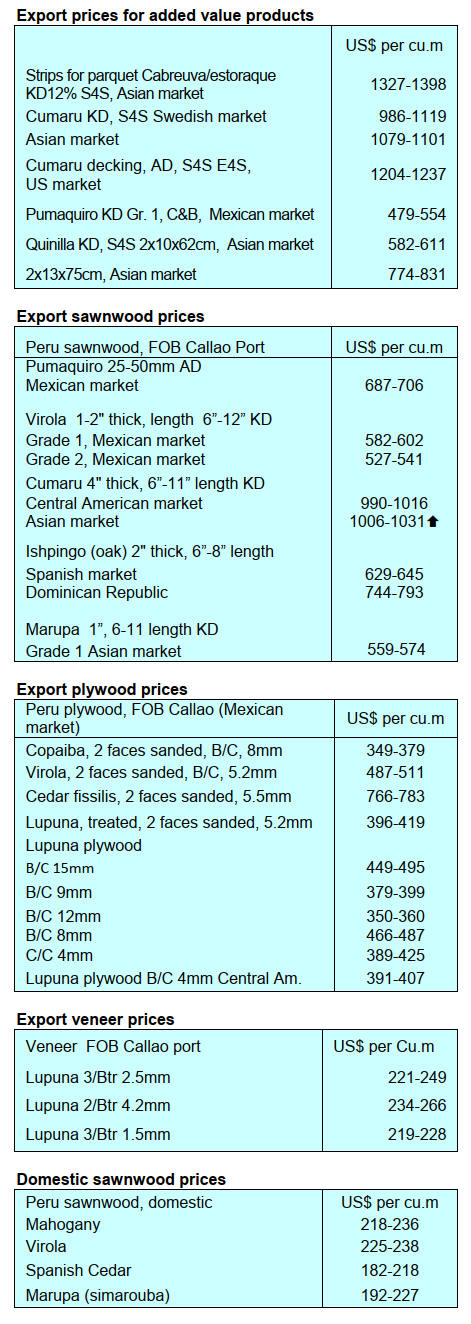
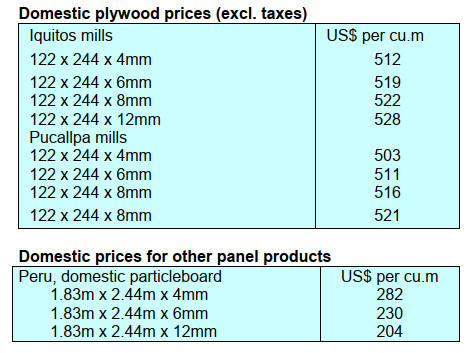
|